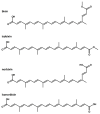Organic Electronics from Nature: Computational Investigation of the Electronic and Optical Properties of the Isomers of Bixin and Norbixin Present in the Achiote Seeds
- PMID: 35408535
- PMCID: PMC9000294
- DOI: 10.3390/molecules27072138
Organic Electronics from Nature: Computational Investigation of the Electronic and Optical Properties of the Isomers of Bixin and Norbixin Present in the Achiote Seeds
Abstract
Organic compounds have been employed in developing new green energy solutions with good cost-efficiency compromise, such as photovoltaics. The light-harvesting process in these applications is a crucial feature that still needs improvements. Here, we studied natural dyes to propose an alternative for enhancing the light-harvesting capability of photovoltaics. We performed density functional theory calculations to investigate the electronic and optical properties of the four natural dyes found in achiote seeds (Bixa orellana L.). Different DFT functionals, and basis sets, were used to calculate the electronic and optical properties of the bixin, norbixin, and their trans-isomers (molecules present in Bixa orellana L.). We observed that the planarity of the molecules and their similar extension for the conjugation pathways provide substantially delocalized wavefunctions of the frontier orbitals and similar values for their energies. Our findings also revealed a strong absorption peak in the blue region and an absorption band over the visible spectrum. These results indicate that Bixa orellana L. molecules can be good candidates for improving light-harvesting in photovoltaics.
Keywords: achiote seeds; natural dye-sensitized solar cells; organic electronic.
Conflict of interest statement
The authors declare no conclict of interest.
Figures










References
-
- O’Regan B., Grätzel M. A low-cost, high-efficiency solar cell based on dye-sensitized colloidal TiO2 films. Nature. 1991;353:737–740. doi: 10.1038/353737a0. - DOI
-
- Kay A., Grätzel M. Low cost photovoltaic modules based on dye sensitized nanocrystalline titanium dioxide and carbon powder. Sol. Energy Mater. Sol. Cells. 1996;44:99–117. doi: 10.1016/0927-0248(96)00063-3. - DOI
MeSH terms
Substances
Grants and funding
LinkOut - more resources
Full Text Sources

